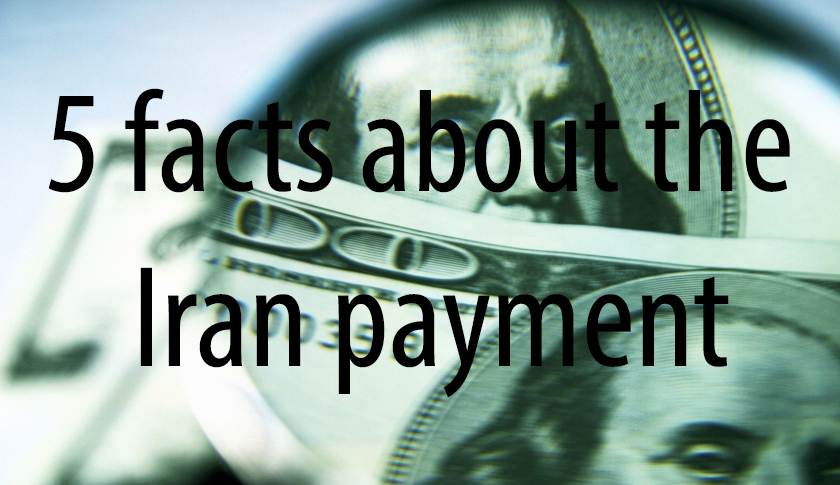From Fortune:
On January 17, the same day five American hostages were released from custody in Iran, a jetliner dispatched from the U.S. delivered $400 million in cash to Tehran’s Mehrabad Airport. Heightening the air of skulduggery, Iranian guards unloaded pallets loaded not with U.S. dollars but Swiss francs, euros and other foreign currencies.
The shipment was a secret until The Wall Street Journal broke the story on August 2. Since then, Republicans from Donald Trump to Paul Ryan have assailed the White House for paying a gigantic ransom when government-paid ransom is barred under U.S. law, and for hiding the ploy from a public already highly skeptical of the U.S.-Iran nuclear agreement. President Obama denied the payment to Tehran was a ransom. The White House contends the payment simply settled a decades-long financial dispute, and that the settlement was fully disclosed in January—although at the time, officials made no mention that the $400 million arrived in Iran the same as the hostages were freed, a confluence of events bound to arouse suspicion.
So what are the facts, as opposed to the spin, behind the $400 million controversy?
What’s Behind the Financial Dispute Between the U.S. and Iran?
In November 1979, Iran’s revolutionary government took 52 Americans hostages at the U.S. embassy, and the U.S. severed diplomatic relations with Tehran. In retaliation, Washington froze $12 billion in Iranian assets held on our shores. The hostage crisis was resolved in 1981 at a conference in Algiers, and the U.S. returned $3 billion to Iran, with more funds going either to pay creditors, or into escrow. The two nations also established a tribunal in the Hague called the Iran United States Claims Tribunal to settle claims both leveled by each government against the other, U.S. citizens versus Iran, and vice versa.
The major issue between the two governments was a $400 million payment for military equipment made by the government of the Shah of Iran, prior to the 1979 uprising that topped him. The U.S. banned delivery of the jets and other weapons amid the hostage crisis, but froze the $400 million advance payment. “The Pentagon handled arms purchases from foreign countries,” says Gary Sick, a former National Security Council official who served as the principal White House aide for Iran during the Iranian Revolution and the hostage crisis. “Defense took care of the details. So the $400 million scheduled purchase was a government-to-government transaction. The U.S. government was holding the money. That’s why it was so difficult to resolve.”
By 2015, the issue stood before a panel of nine judges, including three independent jurists, who were reportedly near a decision on binding arbitration. According to Obama administration officials, the U.S. was concerned that the tribunal would mandate an award in the multiple billions of dollars. “The Iranians wanted $10 billion,” says Sick.”I estimate that the tribunal would have awarded them $4 billion. That’s what the lawyers were saying. It’s not as much as they wanted, but a lot more than we paid.”
So instead, the U.S. negotiators convinced Iran to move the dispute from arbitration to a private settlement. The two sides reached an agreement in mid-2015, at the same time as the U.S. and Iran reached a comprehensive pact on curtailing Iran’s development of nuclear weapons. The financial deal called for the U.S. to refund $1.7 billion to Tehran, consisting of the original $400 million contract for military equipment, plus $1.3 billion in interest.
What Did the White House Say About the $400 Million…and When Did They Say It?
The U.S. announced the controversial nuclear deal with Iran on July 13, 2015. At a news conference on January 16, President Obama declared that the U.S. was lifting the first raft of sanctions against Iran. He also stated that the U.S. would return $1.7 billion to Iran, as agreed in the negotiations at the Hague. That same day, Tehran released the U.S. hostages, and the U.S. freed seven Iranians detained for violating financial and other U.S. sanctions on their home country. Hence, the return of the five Americans appeared to be one side of a prisoner exchange with Tehran.
But Obama didn’t mention that the same day, $400 million was being shipped over 6000 miles for deposit in Iran’s treasury. “Normally you’d use a bank transfer,” says Sick. “But Congress banned dollar transfers to Iran, so the government had to find another way. So they bought foreign currency, and transferred it in cash.”
Why the $400 Million Wasn’t Ransom
The deal’s defenders insist that the financial negotiations were totally separate from both the nuclear deal and the hostage talks, and were led by three separate teams. It’s impossible to verify or refute that information.
A stronger argument is that the U.S. had to make a big payment to Iran because of a 35-year-old deal for weapons that were never received. It wasn’t a matter of if, but when and how much. Washington was worried that the tribunal would impose a payment of several billion dollars, as Tehran demanded, and grabbed the opportunity to settle for the $1.7 billion as part of a overall pact at the same time Iran was benefiting from the nuclear agreement.
It’s also reasonable to ask why Iran would release hostages in exchange for $400 million, when—according to the deal’s defenders—it was bound to get at least that amount from the Hague anyway, and could keep the hostages to boot. Of course, it’s impossible to verify if Tehran was truly convinced a bigger, though later, settlement was likely. Still, it’s clear that the payout from the $400 million dispute was coming, and would happen with or without a release of hostages.
“This was not a quid pro quo for hostages,” says Barbara Slavin, acting director of the Future of Iran Initiative at the Atlantic Council. “It was an opportunity for countries with no diplomatic relations to clear away a number of diplomatic disputes. For the U.S, it was important to get back the detained Americans, and the Iranians wanted their seven citizens out of jail.”
Slavin adds that most of the recent coverage of the U.S.-Iran dealings ignores the importance of the prisoner exchange.
According to Sick: “It was all taken care of at the same time, through separate channels. It was a good deal for U.S. taxpayers, the U.S. obeyed the law, and the payment was always going to happen anyway.”
If It Walks Like a Duck…
The Iranian press and military enthusiastically spun the payment as ransom, and more proof of how Tehran had rolled the U.S. in the nuclear talks.
Most of all, the tale of cash going one way and prisoners the other, all on the same day, just doesn’t look right. The suspicion is that the teams working on the financial, hostage and weapons negotiations did indeed collaborate, and that the hostage release was the essential sweetener needed to clinch the highly controversial nuclear agreement that’s a pillar of Obama’s legacy.
The “sweetener” view may have some validity. Sick concedes that the deal did “let the Iranian hardliners say they got something in the nuclear deal. Iran was happy to get the cash back. Perhaps that made it easier for them to give up the prisoners, I don’t know.” He doesn’t believe the three teams of negotiators were working together. “The negotiations for the hostages were totally separate channels, and handled by the Swiss,” he says.
“The optics do look bad, and the timing was awkward,” says Slavin, a supporter of the nuclear agreement. “But it wasn’t a package deal.”






